Shoulder Strength & Size
One of the first exercises I ever did was a shoulder press. I remember being told by the doctor after fracturing my clavicle in a mountain biking accident that I needed to build back my strength after having my left arm in a sling for 5 weeks.
I was 15 years old and couldn’t wait to get back on my bike doing jumps and stunts with my friends by the woods near to where I lived. I had set up a weight bench and weights in my garage that my older cousin had given to me, and I was eager to build back my strength and improve my mobility.
Within the first week of being cleared to start riding again, I think I was on my bike only a couple of times. I had become infatuated with lifting weights and feeling the burn on my muscles as they reached their maximum capacity. Within the next few weeks and months, my small garage gym had grown and I had a stack of fitness magazines I would use to learn new exercises. I was enjoying getting stronger and watching my body become a physique.
Fast forward to today, and that feeling of pressing weight above my head and chasing the feeling of the burn in the muscles is still as alive as ever. This shoulder routine below is a favorite of mine that focuses on strength and size, whilst still addressing all the major heads of the shoulder for balance and proportion.
Exercise #1: Overhead Shoulder Presses
Target: 5 sets: 1 warm up: 15 reps | 3 progressively heavier sets: 12-8 reps | Final Drop-Set
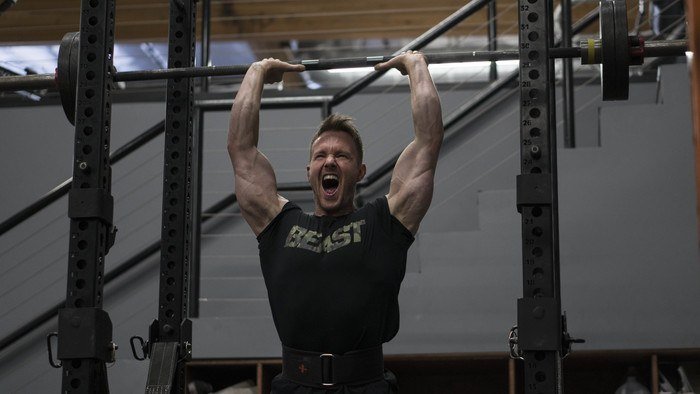
The overhead shoulder press is a great powerful movement for the shoulders, and one of the best for building mass. I personally prefer to use more of a narrower grip, keeping my hand width at about the same as my shoulder width, and lift with my elbows to the front of my body as opposed to at the side.
The reason for this is because I find I can generate a lot more force from this position, driving the bar upwards as I push from my elbows. Once overhead, my arms are not locked out (as this will lessen the load on the shoulders and bring the triceps more into play), and flex the deltoids hard before resisting the weight back down.
For a power move, I would almost always perform this standing, and use a weightlifting belt to help protect my lower back as well as give me more of a rigid foundation from which to push. I will at times perform this from a seated position, although this demands use of much stricter form with less overall weight used.
First, I’ll perform a couple of warm up sets of between 15-12 repetitions, using only the bar, and then a few small plates either side. This helps warm up the muscles and mentally prepares me for the heavier loads to come.
My main working sets usually consist of 3, with one heavy for 10 reps, one all-out to failure for 7-8 reps, and one drop set, of around 5 reps, followed by 8-10 with a reduction in weight. (On the final drop set, I’ll change my hand position to a wider grip, and bring my elbows more out to the side as I push up, which focuses more on the middle deltoid).
You’ll notice from within the video that I’ll use a small bounce to push the weight up, which comes from me bending my knees. This is akin to having a spotter behind me to help spot the weight as it goes up. It’s not something I’ll use for every set, but as I near failure, it can mean the difference between failing and achieving a few more beneficial reps.
Exercise #2: One Arm Shoulder Press
Target: 3 sets: 10-8 reps each
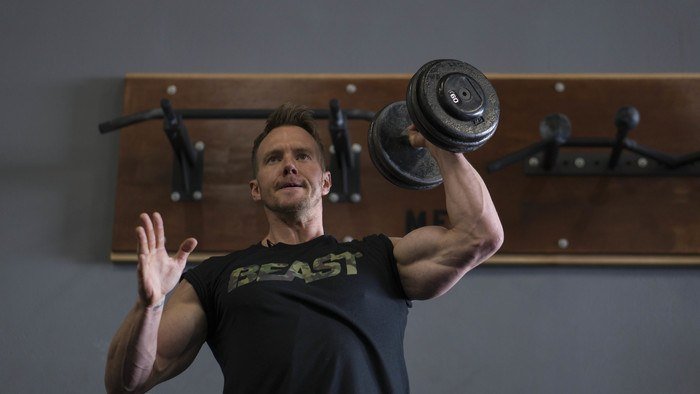
The next movement may look very similar to the first exercise, but by using dumbbells and performing each arm separately, it gives me greater freedom in my range of motion. By using a semi-supinated (neutral) hand position, it allows me to lower the dumbbell lower down to the side of my deltoid, giving it a deeper stretch than when using the barbell.
Doing so places greater stresses on the deltoids throughout a fuller range of motion, which coming off some heavy barbell presses, leaves my shoulders feeling very pumped, and provides a powerful growth, which can lead to a increase in IGF-1 hormones, or in other words – tell you body to grow new muscle.
I’ll typically keep the same weight per set, as you’ll find that after reaching failure on the first working set, if you were to move the next increment up (which for dumbbells is usually a 5lb increase), it will limit you in performing close to the same repetitions. With this said, you should be aiming to use a weight that will really push you for 8 reps.
Whichever arm you start on, say the right arm, followed immediately with the left arm (no rest between switching arms), allow enough recovery where you feel as though you could get close to the same repetitions, and on the next set, start again with the left arm, finishing the 3rd set with your right arm again. Doing this will ensure that you don’t always rely on your more dominant side to start a new set.
Exercise #3: Bent Rear Delt fly & Rear Delt Cable Fly*
Target: 3 sets each. 12 & 15 reps each, respectively.
*Perform both exercises as a superset with no rest between each movement
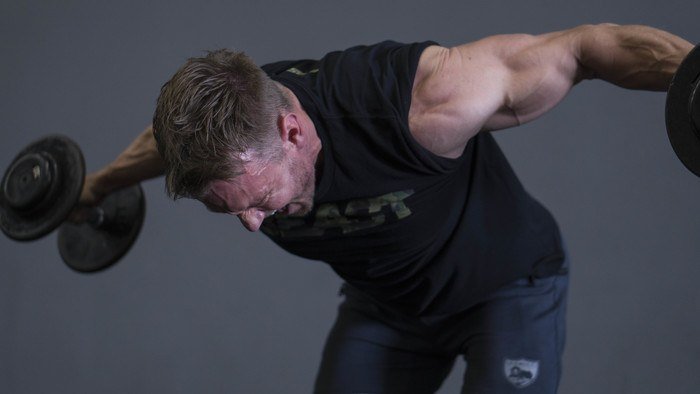
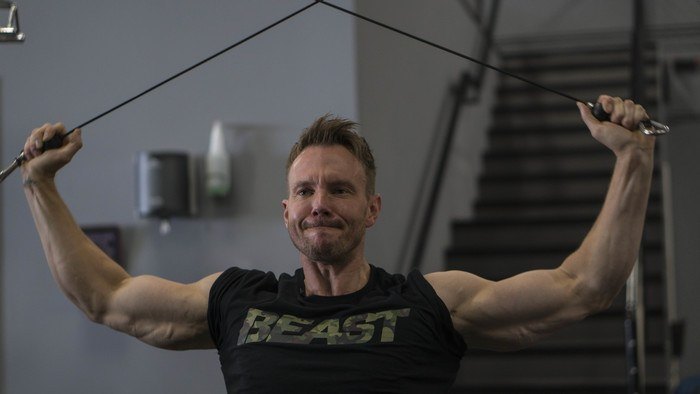
With the heavier, compound-type presses out of the way, it’s now time to focus on isolating specific heads of the deltoid, and with the posterior (rear) deltoid often getting neglected in favor of middle or front deltoids, I like to focus on these next.
Well-developed posterior deltoid heads can have a big impact on the look and shape of your physique, especially if your focus is to step on stage and compete. Even if not, they can help tie in the arms to the shoulders, and give the whole shoulders and upper back a thicker and wider appearance.
Both of these exercises rely on the same movement to engage the rear deltoid, but one uses free weight, which I find works better for mass development, and the use of cables helps to really focus on the contraction and squeeze deep within the muscles.
The other difference that is worth noting between these two exercises is the hand position and the motion of effort. On the dumbbell version, my hands are in a pronated (overhand) grip, and my arms are opening outwards (keeping the arm complex in a fixed position, with the elbow slightly flexed to keep the triceps from becoming too involved), in a similar manner a chest fly, except instead of pulling the arms together in that fixed position, I am raising them back behind me, leading with the elbows.
Within the cable variant, I have a semi-supinated (neutral) grip, actually holding on to the cable itself and not a handle, so that my grip can follow the same motion of my arms (still in that fixed position with the elbow slightly flexed), as I draw my elbows downwards as opposed to out behind me. I’ve tried many different variations of this movement, and feel the most effective is to kneel under the cables (as they cross over above me – right hand holding the left cable, and right hand holding the left).
Creatine Supplementation
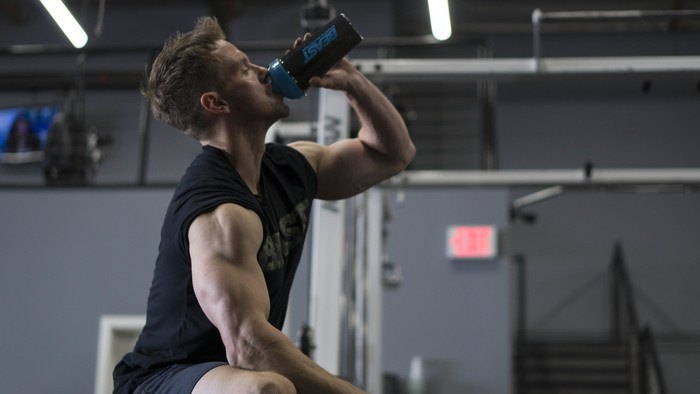
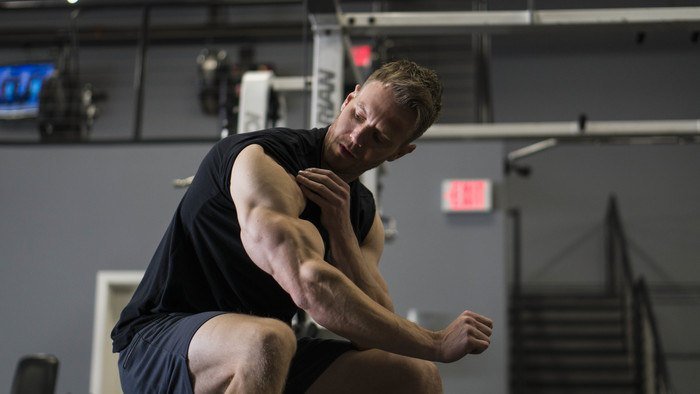
I’ve recently just added a Creatine supplement back into my routine, to help towards greater strength and lean muscle gains, as well as assisting towards increased recovery time.
As seen within the video, I’m using Beast Creature, which is a proprietary blend of five types of creatine. Creatine Monohydrate is one of the most scientifically researched supplements available and supports the production of ATP, the muscles primary source of energy in the body. Creatine Anhydrous is Creatine with the water molecule removed and Crea-Trona® is a buffered form of creatine. It delivers a results-inducing ratio of 94% creatine to 6% buffering agent.
Exercise #4: Single Arm Lateral Raises & Plate Front Raise*
Target: 3 sets each. 12 reps each.
*Perform both exercises as a superset with no rest between each movement
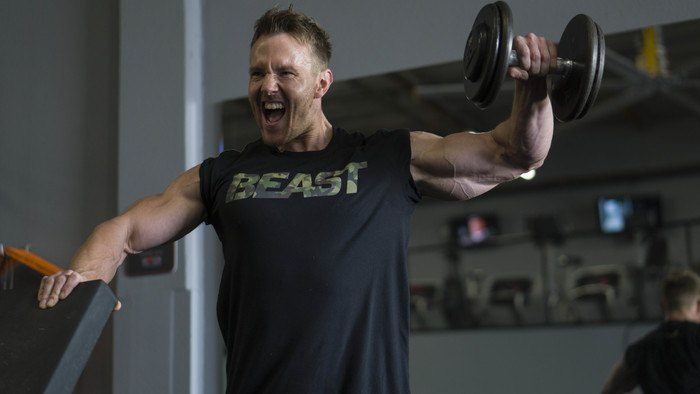
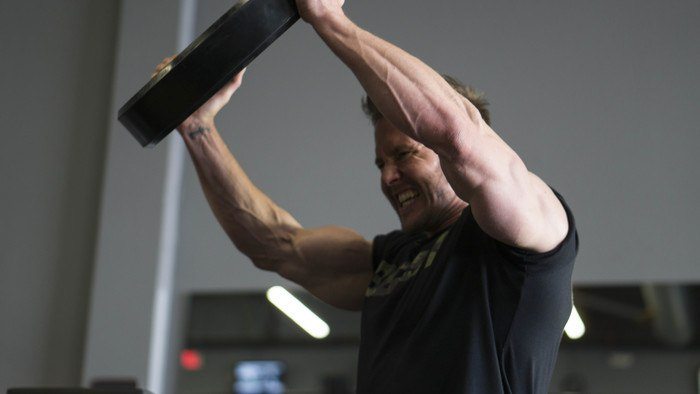
All that’s left to work now is the middle and anterior (front) deltoid heads, both of which are involved in a lot of other movements (including most pressing movements, and several types of curl movements). This is why I work them at the end of the training session, so that other muscles get priority that need a greater focus on.
I like to perform side lateral raises one arm at a time, so I can allow for a greater range of motion and focus on truly feeling the middle deltoid get worked, without as much momentum that typically occurs when performing both arms together. This actually translates into using a heavier weight for single arm side raises, allowing me to place greater stresses on the muscles – leading to better growth. You can see within the video that I do perform the 3rd set as seated lateral raises, using both arms. This is because I’ve reached the point of failure with the heavier single arm raises, and want to finish with a focus on stricter movement (lowering the weight, but still aiming for the same rep-range).
The final movement of this superset combo is a front raise, which targets the front deltoid heads. Like with most exercises I perform, I’ll change a variable every other week, and so within this routine I chose to use a semi-supinated (neutral) hand position as opposed to a pronated (overhand) grip. The first allows me to perform it holding a weight plate, or dumbbells, whilst the latter requires a barbell or dumbbells.
As with both of these movements, I keep my arm structure fixed with only a slight flex at my elbow. The deltoid heads will be worked the most effectively as the weight is raised up towards the height of the shoulder. Anything higher than that will bring the traps into play – which isn’t necessarily, a bad thing, but it will relieve the deltoids from doing the majority of the work.
1 Comment
Comments are closed.
You’re so awesome! I don’t suppose I’ve read through anything
like this before. So nice to discover somebody with original thoughts
on this topic. Really.. thank you for starting this up.
This site is one thing that’s needed on the internet, someone
with a little originality!